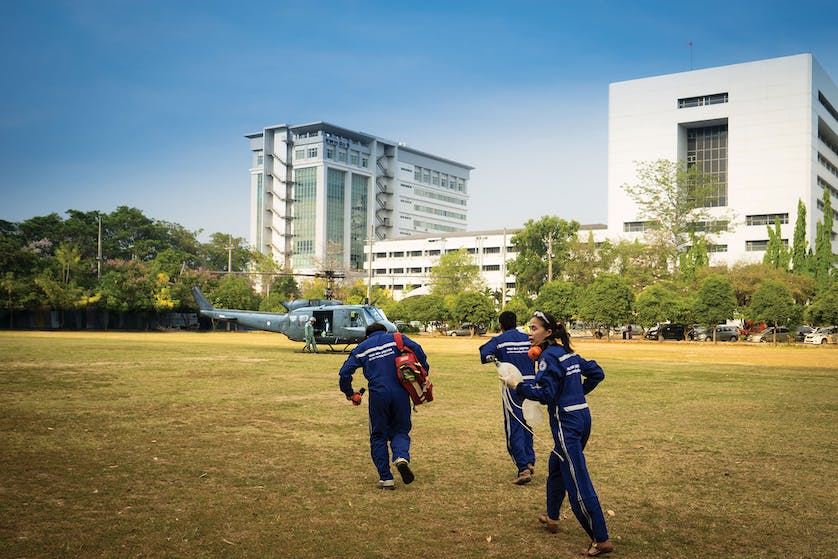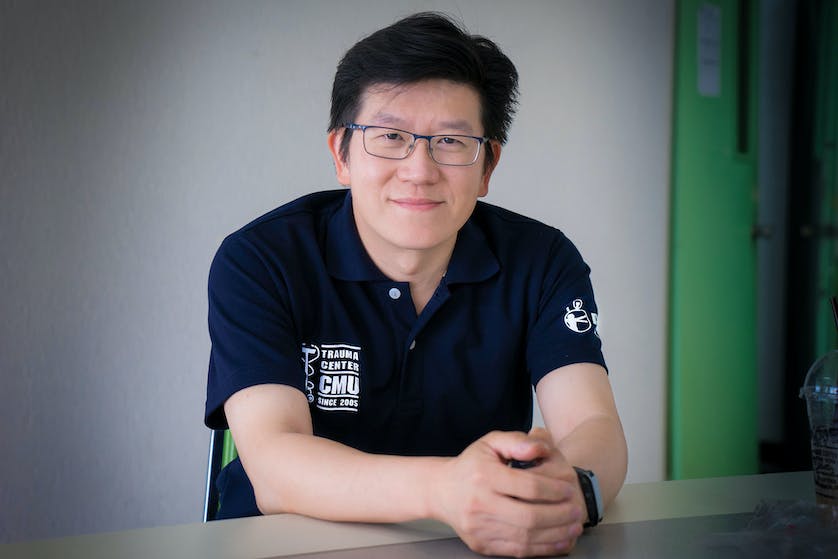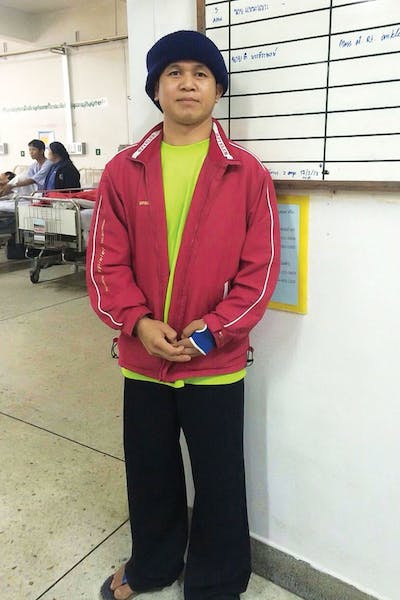“I’m sure at least some of you have been in an accident or have fallen ill and have had to be rushed to hospital at one point or another,” said Narain Chotirosniramit, full time surgeon at Chiang Mai University and deputy director of Maharaj Nakorn Chiang Mai Hospital, as he kicked off his talk at TEDxChiangMai recently. “You call 1669 or any emergency number and an ambulance heads out, with emergency response teams who are the first to help and monitor you throughout your short journey to the nearest hospital. When you arrive, there are nurses and doctors who are ready and waiting to help in those crucial moments you need them the most. But what about those people up in Mae Hong Son, miles away from any emergency room who live a five hour drive from the nearest hospital? What about them?”

The rugged terrain of the north of Thailand means that there are many villages far off the beaten track. As can be expected, serious accidents and emergency health issues are just as likely to happen here as anywhere else, but without a team of doctors within reach, the chances of survival plummet.
A farmer tilling his land three hours walk away from his village may injure himself in a freak accident. He will then have to be carried all the way back by foot to his village where a mode of transport will have to be found, most often a motorbike or pickup truck, he then is likely to suffer through the bumpy and often dangerous mountain roads before heading to a rural hospital where medical equipment or expertise is simply not there. It could then be another day before he can be transferred into Chiang Mai for much needed help, if he makes it all.
“If we are slow to reach medical attention, we die,” Narain went on to tell the crowd at TEDx, as he explained the need for Sky Doctors — a team of dedicated on-call volunteers who fly in helicopters or small planes to emergency medical situations throughout the north. “We can cut travel time by hours, giving those who are in need of serious medical attention the chance of life, rather than almost inevitable death.”

The Sky’s the Limit
“It all started when the army began helicoptering their soldiers, wounded in combat along the border, several years ago,” explained Narain when Citylife met him at Maharaj Nakorn Chiang Mai Hospital to find out more about who the Sky Doctors are and what they do. “A small team of doctors from Mae Hong Son thought to themselves, if the army can do it, why can’t we?”
From that day, some six years ago, this small team has grown into a fully-fledged, government sponsored, group of roughly 200 doctors, pilots, coordinators and medical directors. Starting with negotiations with the Air Force, the original team began by flying patients to Chiang Mai in the back of the same Air Force helicopters that transports injured soldiers.
Although working well for a time, the team was small and the budget even smaller. In fact, they were all volunteers, banded together because of a mutual desire to really help those in hard-to-reach places — a service which Narain believes is a right to every person in Thailand. A right yet to be fully realised.
Soon after the project gained momentum, The National Institute for Emergency Medicine (NIEM), a non-profit governmental organisation which funds projects such as prehospital care, emergency medical services such as the 1669 rescue teams and emergency disaster relief, took interest in the small team of sky doctors, finally giving the green light and enough funding to see the Sky Doctors soar higher than ever imagined.
Once the collaboration began, the Sky Doctors expanded across the north, with a more central command centre set up in Chiang Mai, headed by some of the original team, and other senior medical directors from hospitals across the city.
“Right now we are scheduled on standby so we almost always have a team ready to go,” said Dr. Narain proudly. “Each doctor has also been trained to an advanced level before they can fly with the Sky Doctors, to ensure utmost security and welfare of everyone on board.”
“It starts with a basic training programme,” explained Dr. Narain. “A group of medical lecturers from Bangkok come to Chiang Mai, and along with doctors from the Air Force, Bangkok Hospital and universities in Chiang Mai, train all of our new volunteers every couple of months.” However, it is the advanced training that awards the doctors their wings. Sponsored by NIEM, doctors from Bangkok Hospital and the Air Force train alongside expert doctors with extensive experience in air based rescue from Japan, South Korea and Italy. “Every year NIEM hosts the training event in Chiang Mai, where all of the doctors involved must attend.”
Despite some turbulence on the way, the Sky Doctors now have a fully working (air)ship that can respond within the hour to any call made to them directly from Mae Hong Son, Chiang Mai, Chiang Rai and Nan. However, the process to contact, organise, fly and assist can be a difficult job to be in charge of, a job often left to Dr. Narain.
Time’s Not on Our Side
“Time is the most crucial limitation to whether someone can be saved or not, and the only way to conquer those remote places, is to fly,” Dr. Narain Explained to the TEDx crowd, before describing the limitations that the Sky Doctors face every time the red phone rings.
“Unlike other countries, we do not have access to our own aircraft,” said the doctor, with frustration in his voice. Currently, the Sky Doctors now based in Chiang Mai have access to only three aircrafts. One Air Force helicopter, one police helicopter and a small fixed wing aeroplane owned by the Chiang Mai based airline, Kan Air.
When NIEM began funding the Sky Doctors, they pledged to support the cost of hiring aircrafts. After extensive research, they settled on a fixed price of 40,000 baht per hour that would be paid to whoever the aircraft was hired from. This covers the cost of the aircraft, fuel, and pilot time.
“The second most important thing we need to do when a call comes in is to see if any aircrafts are available,” Dr. Narain explains. “This includes pilots, fuel and good weather conditions all at a moment’s notice — something that can sometimes be problematic.” In fact, the Sky Doctors rely heavily on the private airline Kan Air, which flies around 40 percent of emergencies and is the only aircraft that will fly at night. “If we lost Kan Air, we’d lose any chance of flying to remote areas at night time,” a realistic worry given the recent press regarding the financially precarious situation of several Thai airlines, including Kan Air.

“Kan Air has delivered medical equipment, drugs and mothers’ milk across the country for free for years already,” Dr. Narain said as he went on to express how much of an asset Kan Air is to the Sky Doctors and how sad it would be for Thailand to lose such a socially conscious company. “Right now they are even giving anybody in Mae Hong Son who requires non-emergency medical treatment in Chiang Mai a free return ticket for two until August.”
Yet despite the fact that an aircraft is needed to be able to fly in the first place, it is not the most important decision to make. When asked what that decision was, Dr. Narain sat back in his chair and opened his laptop. “Let me show you the hard question we need to ask ourselves every time a call comes through; is the case hopeless or not?”
The Hopeless and the Hopeful
“It may sound cold hearted, but if someone has had three heart attacks and is losing a lot of blood, even we won’t make it in time,” the doctor said solemnly while explaining sometimes there is simply nothing that can be done. This decision is not taken lightly, however, and there are often several senior medical directors who step in to evaluate the situation and collectively make that very hard decision.
Each call made to the Sky Doctors comes from a senior medical representative of the first response teams involved when accidents or serious medical emergencies occur in remote provinces like Mae Hong Son. These tend to be rural hospitals, those closest to the patient. “It is these doctors who then decide if the patient needs medical treatment in Chiang Mai, and if so, they’ll call us directly.”

After the call is made, the Sky Doctors’ LINE group bursts into action, with messages, photos, x-rays, test results, opinions — and the prerequisite stickers — shared amongst group members. A final decision is based on input from all relevant doctors.
“In March, there was a case of an 8 year old boy whose head was crushed by a falling tree in Mae Hong Son. The decision was borderline, but given his age, we had to try.” The call came in at 1.20pm and they doctors were in the sky by 2.30pm, flying low and fast towards the school where the accident happened. By the time they arrived, the young boy had suffered two heart attacks and blood was pouring out of his nose.
The Sky Doctors flew the child back to Chiang Mai where he was x-rayed and rushed into surgery. However, with severe skull damage and loss of blood, the boy didn’t make it.
Narain paused after telling this story, clearly still affected by the boy’s death but not disheartened about the Sky Doctors’ ability to save those in need. He continued to explain that the majority of cases are classified successes and went on to describe one of his favourite stories, one that he had also shared at his TEDx talk.

“He made a full recovery,” Dr. Narian beamed as he clicked his mouse, showing the next photo the patient standing tall and dressed to leave the hospital. “Apart from a few stroke-like symptoms, the man was completely healed, with no permanent damage to his brain, something that would have been impossible without the Sky Doctors’ help.” He continued to share a few more anecdotes of success stories, obviously proud of his team’s role in saving so many lives.
Gaining Altitude
Now there are Sky Doctors in Tak, Surat Thani and Phuket, all set up following the North’s successful model. With the help of NIEM, funding is continuing for the foreseeable future, though with more support, so much more could be achieved.
“In Thailand, budgets are limited, especially when it comes to helping minorities,” said Dr. Narain, explaining how for a long time it was seen as a waste of money to help these poor, isolated communities. “They don’t pay taxes, they aren’t registered citizens, they don’t speak Thai,” are all common excuses and criticisms the Sky Doctors hear when seeking new sponsors. Although his disdain for such opinions is clear, the doctor remains confident that over time, more funding will be found and has hopes that one day the group can turn into an official organisation, offering medial response and relief to those in need throughout Thailand.
“What we really need is our own helicopter,” Dr. Narain said when asked about the future of Sky Doctors. “If we had our own helicopter, we could fly within minutes, rather than hours, conquering the incredibility important limitation of time even more.” He went on to explain that due to the lack of knowledge about his team, they are only receiving about two calls a week, but expects that this number will rise in the future.

Time is of the essence when it comes to emergency medical response. Whether it be by road or by sky, it is eventually time that decides many patients’ fates. The majority of cases the Sky Doctors accept are at the very least salvageable, giving a new chance of life to the otherwise hopeless patient found high on a mountain ridge or in a small provincial hospital without the doctors or resources to help them.
Dr. Narain has yet to have an opportunity to talk directly to more senior members of the government, but has hopes that when he does, they will realise the significance of the Sky Doctors’ endeavours and support them so that something as basic as quality emergency medical care can be received by all people in Thailand, not just those living within a stone’s throw of a hospital.
The Sky Doctors have taken off, but there are some turbulant skies ahead and without full government support, the group will continue to struggle to stay aflight. This hard working and dedicated group of volunteer doctors needs all of our support and appreciation and we hope that they continue the fight to save lives.
If you wish to donate a helicopter or contact the Sky Doctors, you can call 053 936606.
